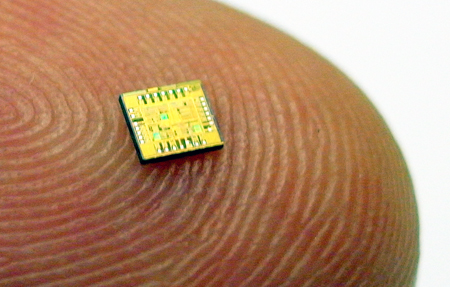12 Nov 2014
Fraunhofers demo new optical healthcare systems at Düsseldorf health technology expos.
This week, two collocated medical trade expos in Düsseldorf, Germany – Medica and Compamed – are showcasing a range of new healthcare systems. In particular, two photonics-based innovations, developed by Fraunhofer research centers, are designed to speed up testing for prostate cancer and improve health monitoring of the elderly in the home, respectively.
Improving prostate cancer diagnosisDistinguishing between benign and malignant prostate tissue is difficult. A new device developed at the Fraunhofer Institute for Ceramic Technologies and Systems can improve the diagnosis for doctors. Now, by straightforward and speedy visual analysis, they can reliably determine if they are dealing with carcinoma in just 90 seconds.
Conventionally, a doctor wishing to determine whether a man has carcinoma of the prostate gland or just a benign tissue change has to take a biopsy of prostate tissue from the patient. In doing so, they insert a small needle into the prostate, which requires ultrasound imaging to assist with navigation. From the sample taken in this way, laboratory staff fabricate wafer-thin tissue sections – a laborious job that takes at least a day – and that is before a pathologist can even examine them under the microscope. But even for experienced physicians it is often difficult to distinguish between benign and malignant tissue.
90 second test
The Fraunhofer IKTS develors say that their new optical diagnostic device, now on show at Compamed, will make prostate cancer research “easier, faster and more precise”. Dr. Jörg Opitz, a scientist at IKTS, explained the procedure, “The physician places the tissue sample on a base plate, slides it into the machine, presses a button – and within one and a half minutes, receives a reliable indication of whether the tissue in the sample is benign or malignant."
Since the sample does not require a long preparation time and can be analyzed just after it has been taken, the patient does not have to wait for days after the biopsy to know the outcome. A further advantage is the reliability of the examinations. "The analyses are based on the auto-fluorescence that human tissue emits", says Opitz; there are fluorophores in every human body.
The scientists have been able to determine a clear threshold for this different behavior: If the value of the tissue sample exceeds the threshold value, carcinoma is present. Thus, the doctors obtain a clear and unambiguous prognosis. The analysis proceeds automatically. The device shows the physician if the collected sample contains cancer tissue like the colors of a traffic signal.
Currently, the device can only be used for prostate cancer, since the threshold value of the unit only applies to this tissue. But the researchers’ goal is to determine the threshold values for other tissue types and to integrate them into the analysis software of the device. Then, the doctors will be able to examine different samples with the device: They would only need to enter the appropriate tissue type from a drop-down menu.

Microchip for the electrochemical detection of biomarkers.
The developers say that cardiac diseases have long been the most significant cause of death globally. Mobile assistance systems that monitor vital parameters, such as blood pressure or heart rate, of at-risk patients in their homes could boost both safety and quality of life. This platform has been co-developed and tested by researchers from Fraunhofer FIT, the Berlin Charité (university hospital), comms company T-Systems and several international partners.
Wearable sensors for measuring vital parameters can be linked to the home unit, e.g. a pulse oximeter with a Bluetooth module in the patient's ear or a blood pressure monitor that sends its data to the system wirelessly. Using an electrochemical sensor, the system can measure the patient's glucose, lactate or cholesterol level. In addition, a fluorescence sensor using a laser diode captures the concentration of several cardiac markers.
To detect the risk-indicating markers in the blood, the patient uses a cartridge that she fills with a drop of blood from a prick in her finger. The cartridge is equipped with a microchip and also specially designed, so that the markers in the blood can be detected.
"Miniaturized sensors in the home unit, which can detect traces of the markers down to the nano level, analyze the blood sample", said Professor Harald Mathis, head of the department 'Biomolecular Optical Systems' of FIT. The home unit aggregates the sensor data and sends the results to the patient's doctor or a medical center via secure Internet connection. A smartphone app presents the health data and the physician's feedback to the patient.
About the Author
Matthew Peach is contributing editor to
| © 2024 SPIE Europe |
|